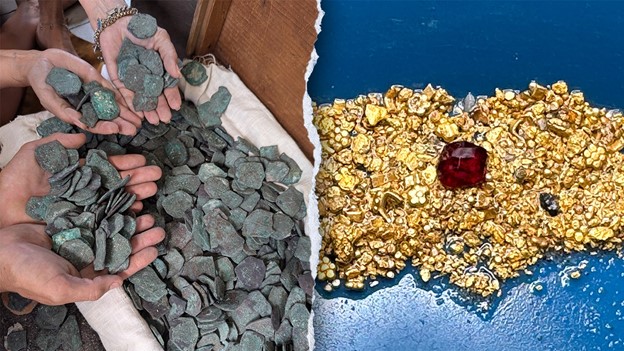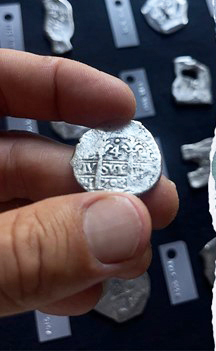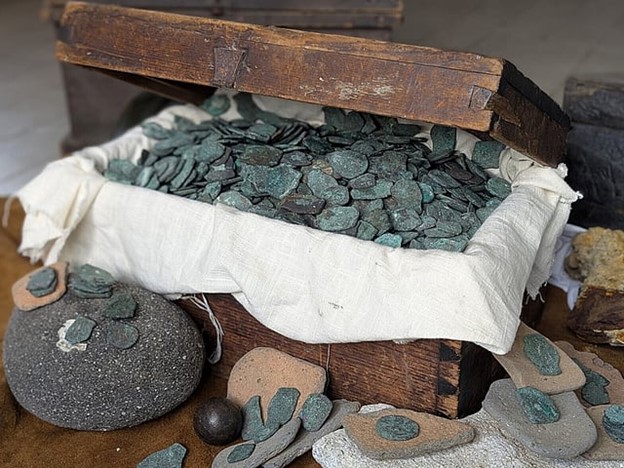Soggy Spanish treasure
Hidden beneath the turquoise waters of Florida’s famed “Treasure Coast,” a team of divers has struck gold — quite literally. A shipwreck salvage crew has uncovered more than 1,000 silver and gold coins believed to date back more than 300 years, with an estimated value of around $1 million. More than 1,000 gold and silver coins from a lost Spanish were fleet recovered in a rare haul. “1715 Fleet – Queens Jewels LLC” is one of the companies licensed to search the area for remnants of the lost Spanish fleet. The coins are thought to have been minted in the Spanish colonies of Bolivia, Mexico and Peru. They were part of a vast treasure shipment heading back to Spain when disaster struck in 1715. On July 31 that year, a powerful hurricane wrecked a fleet of 11 Spanish galleons laden with gold, silver and jewels collected from the New World. The ships went down between present-day Melbourne and Fort Pierce, scattering their riches across the seabed — the area now known as the Treasure Coast. Over the centuries, salvagers and explorers have recovered millions of dollars’ worth of coins and artifacts from the site. Yet new discoveries like this one continue to surface, fueling fascination with one of history’s most storied shipwrecks.
Many of the recovered coins still bear visible dates and mint marks — details that historians and collectors say are invaluable. “This discovery is not only about the treasure itself, but the stories it tells,” said Sal Guttuso, operations director for 1715 Fleet. “Each coin is a piece of history, a tangible link to the people who lived, worked and sailed during the Golden Age of the Spanish Empire. Finding 1,000 of them in a single recovery is both rare and extraordinary.” The team used metal detectors, underwater scanning tools and manual sand-fanning techniques to locate and extract the coins from the ocean floor. Under Florida law, historic artifacts found in state waters belong to the state, though licensed excavators are allowed to conduct recovery operations. About 20% of all recovered items are kept by the state for research or display in public museums.
Sal told the Associated Press his team maintains a detailed inventory of every find, which is reviewed by state officials. The rest of the artifacts are divided between the company and its subcontractors after court approval. “Due to the size and great condition of the coins in this discovery, we will be able to learn a great deal regarding where and when they were minted,” Guttuso added. “This will provide us with a time capsule of Spanish colonial numismatics from the New World. Each coin is a piece of history, a tangible link to the people who lived, worked and sailed during the Golden Age of the Spanish Empire,” Sal said. “Finding 1,000 of them in a single recovery is extraordinary.” The coins will undergo conservation before they’re put on public display. “Every find helps piece together the human story of the 1715 fleet,” Sal explained. He added, “We are committed to preserving and studying these artifacts, so future generations can appreciate their historical significance.”
Laughing under water
So, why do scuba divers fall backwards out of the boat?
Because if they fell forward, they’d still be in the boat.
My SCUBA instructor always stressed that you should never go diving alone.
If you have equipment problems, your buddy can help you. If you run out of air, your buddy can help you. If you meet an aggressive shark, your odds are 50-50 instead of 100%.
I found a wallet with 20 dollars in it. I wasn’t sure How to proceed. But then I thought,
“What would Jesus do?” So I turned it into wine… It was a religious experience.
What do you call an underwater town made up of multi-ethnic scuba instructors?
Dive-ercity.
October 10th Birthdays
1989 – Rose Mc Iver, 1978 – Andrea Navedo, 1990 – Aimee Teegarden, 1950 – Nora Roberts
1970 – Dale Earnhart, Jr. 1946 – Ben Vereen, 1969 – Brett Favre, 1955 – David Lee Roth





